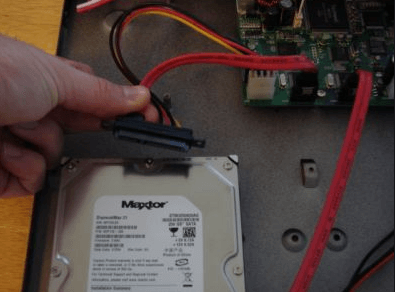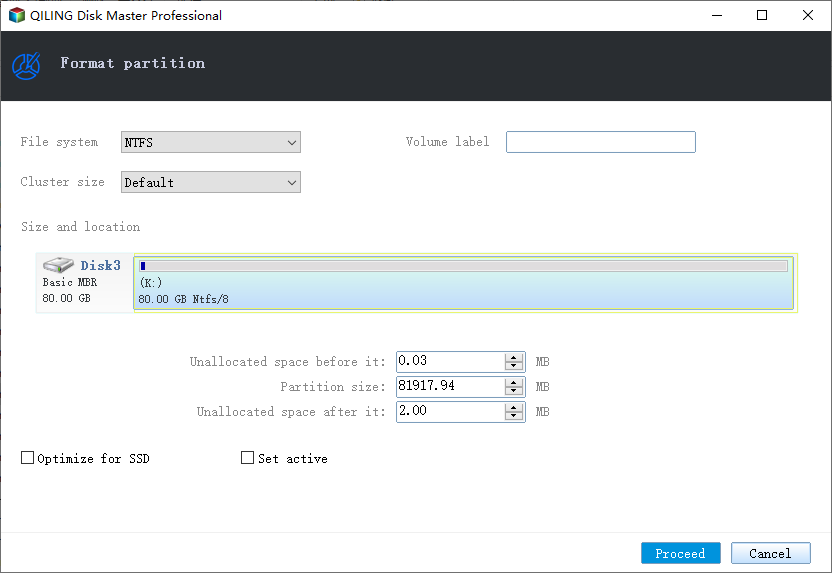How to Format DVR Hard Drive for PC
4 Tips to Format a DVR Hard Drive for Windows 11/10/8/7
Whenever you use a digital video recorder, it often contains a hard drive for saving videos. This hard drive is - DVR hard drive. If you want to use this hard drive on a Windows PC, you need to connect the DVR to your PC and format the DVR hard drive by the following tips.
| Workable Solutions | Step-by-step Troubleshooting |
|---|---|
| Tip 1. Format DVR with Software | Run Qiling Partition Master, right-click the hard drive partition you intend to format...Full steps |
| Tip 2. Use Disk Management | Right-click on the Windows icon and select "Disk Management"...Full steps |
| Tip 3. Format DVR with File Explorer | Click "This PC", Right-click on the connected DVR hard drive partition and select "Format"...Full steps |
| Tip 4. Run Command Prompt | Type cmd in the search box in Windows 11/10, right-click on "Command Prompt"...Full steps |
How to Unlock/Connect a DVR on a Windows PC
To connect a DVR hard drive to your computer, you'll need a Phillips screwdriver. Then, follow these steps to remove and connect the DVR hard drive to your Windows hard drive.
Steps 1. Unplug the computer's power cord from the outlet. Remove the screws from the side panel, using a Phillips screwdriver.
Step 2. Remove the screw at the edge of an empty drive bay inside the computer, near its top edge, using the screwdriver. Pull the drive tray out of the drive bay. Then, remove the two screws from the sides of the drive tray with the screwdriver. Slide the DVR drive into the drive tray's slot, connector side out. Reattach the screws.
Step 3. Pull the power plug and data cable plug out of the drive bay. Connect the power plug to the power socket on the back of the DVR drive. Connect the data cable plug to the data socket on the back of the DVR.
Step 4. Insert the drive tray back into the drive bay and reattach the screw. Put back the side panel and other things.

Then, you can turn on your computer and start the DVR formatting process.
Tip 1. Format DVR Hard Drive with Professional HDD Formatter
How to format a DVR hard drive on Windows OS? That's not a big problem if you get to know this third-party partition magic software called Qiling Partition Master. It is an easy-to-use hard drive formatter. With it, you can convert to NTFS or FAT32 with simple steps. What's more, it supports many file system types, including NTFS/EXT3/EXT2/FAT32/FAT16/FAT12/ReFS.
In addition to hard drive formatting, you can also partition a hard drive, merge partitions, and clone a hard drive with it. Download and install Qiling Partition Master on your Windows computer to format a DVR hard drive in Windows 11/10/8/7.
Step 1. Run Qiling Partition Master, right-click the hard drive partition you intend to format and choose "Format".

Step 2. In the new window, set the Partition label, File system (NTFS/FAT32/EXT2/EXT3/EXT4/exFAT), and Cluster size for the partition to be formatted, then click "Proceed".

Step 3. Then you will see a warning window, click "OK" in it to start formatting the partition on your hard drive.
Formatting hard disk will erase data as well, do remember to back up your hard drive data if it's concerned. Otherwise, you can directly perform DVR data recovery.
Tip 2. Format DVR Hard Drive with Windows Disk Management
If you don't want to download any software, you can format a DVR hard drive with Disk Management. It is a Windows built-in tool that enables you to create, delete, extend, shrink, and format partitions. Here are the steps to format DVR with Disk Management.
Step 1. Right-click on the Windows icon and select "Disk Management".
Step 2. Right-click on the DVR drive and click on "Format".

Step 3. Select the file system and set the cluster size. (Windows users often use NTFS and FAT32)
Step 4. Click "OK" to format the drive.
Tip 3. Format DVR Hard Drive Using File Explorer in Windows 11/10
Another easy way to format a DVR hard drive is by using File Explorer. You can format the DVR hard drive with simple steps.
Step 1. Click "This PC", Right-click on the connected DVR hard drive partition and select "Format".
Step 2. On the format window, select the desired file system for your device.
Step 3. Check "Quick Format" and click "Start".

After this, click "OK" to confirm and finish the formatting. If you have several partitions, you can repeat these steps.
Tip 4. Run Command Prompt to Format a DVR Hard Drive
If you are familiar with Command Prompt, you can take this method into account. But you should be careful of every step because any false operation may cause serious results.
Step 1. Type cmd in the search box in Windows 11/10, right-click on "Command Prompt", and choose "Run as administrator".
Step 2. In the command prompt, type diskpart and press "Enter".
Step 3. Input the following command lines and hit "Enter" each time:
- list disk
- select disk + disk number ( for example, select disk 2)
- list volume
- select volume + volume number
- format fs=ntfs

Then, type exit and hit "Enter" to finish this DVR formatting process.
Why Are the DVR Hard Drive Not Recognized by a Computer
Likewise, when you surprisingly find that a healthy DVR hard drive would not spin up or power after putting it into a normal Windows 11/10/8.1/8/8 computer, it's a common phenomenon. As long as the hard drive still works fine in the original DVR box, there is nothing to be worried about. After knowing what the exact DVR hard drive file system is, you can easily get over this problem and successfully use it on a computer.
In general, depending on whose DVR it is, e.g., Dish or DirecTV, the hard drive could be preformatted to the XFS file system which is Linux file system based.
If there is a Linux PC/laptop available, try to attach the DVR hard drive to it and see if Linux can recognize it. However, nowadays people are using Windows operating system in common and using this drive for a PC, you can only format the DVR hard drive to NTFS or FAT file system which Windows can detect, read and write.
Conclusion
That is all about how to format a DVR hard drive for a PC. If you want to format the DVR drive for a Linux device, you can create a bootable USB drive and format the DVR hard drive on a Linux device. Qiling disk management software provides you with the best solutions.
Formatting the DVR Hard Drive FAQs
If you have some other related questions about DVR hard drive formatting, you can read these questions and answers below.
What format does DVR use?
While there's no doubt that DVR systems are highly efficient, finding the right DVR box is important as it is essential to ensure that the user will meet all his security requirements. Some DVR supports Windows and some support Linux. DVRs can usually record and play H.264, MPEG-4, MPEG-2, VOB, and ISO images video, with MP3 and AC3 audio tracks.
Can a surveillance hard drive be used on the desktop?
Though surveillance drive performed better than desktop, it doesn't mean you use surveillance drive in PC. Both are engineered for different functions, so if you are setting up a PC go for a desktop drive while setting up a CCTV better to choose video-optimized surveillance drives.
How do I force format my hard drive?
Four tips to format DVR hard drive:
- Tip 1. Format DVR Hard Drive with Professional HDD Formatter
- Tip 2. Format DVR Hard Drive with Windows Disk Management
- Tip 3. Format DVR Hard Drive Using File Explorer in Windows 11/10
- Tip 4. Run Command Prompt to Format a DVR Hard Drive
Can I use SSD on DVR?
Depending on how many shows you're recording (and whether your DVR supports live caching), it may be viable to use an SSD in a DVR.
Related Articles
- The Volume Is Too Big for FAT32 Windows 11/10, Fixed Here!
- How to Optimize Windows 11 for Gaming (6 Ways)
- Patriot Formatter | The Best USB Format Tool for Patriot Flash Drive
- SD Card Repair Tool - 10 Ways to Fix Corrupted Memory Card